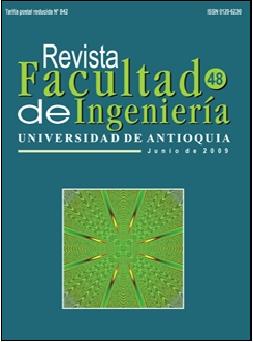UML2SC: A tool for developing complex electronic systems using UML and SystemC
DOI:
https://doi.org/10.17533/udea.redin.16527Keywords:
UML, SystemC, hardware, software, system-level design, SoCAbstract
In this paper, we propose a transformation process in which SystemC skeleton code is extracted from UML models that describe hardware/software based systems. The tool UML2SC, which is based on Java libraries, is also introduced. This tool allows the transformation of UML class and composite structure diagrams to SystemC skeleton code. An implementation example is given to illustrate the transformation process implemented in the UML2SC tool. The example describes the model of a CPU RISC of 16 bits.
Downloads
References
G. Martin, W. Müller. UML for SoC Design. Springer. Netherlands. 2005. pp 17-36. DOI: https://doi.org/10.1007/b135980
OMG, Unified Modeling Language: Superstructure, version 2.0, formal/07-03-05. Disponible online: http://www.uml.org. Consultada el 25 de mayo de 2008.
SystemC home page. Disponible online: http://www.systemc.org. Consultada el 14 de febrero de 2008.
V. Sinha, F. Doucet, C. Siska, R. Gupta, S. Liao, A. Ghosh. “YAML: A tool for hardware design visualization and capture”. Proc of the 13th international symposium on System Synthesis. 2000. pp. 9.
K. Nguyen, Z. Sun, P. Thiagarajan, W.F. Wong. “Model-driven SoC design via executable UML to SystemC”. Proc. of RTSS. 2004. pp. 459.
W. Tan, P. Thiagarajan, W. Wong, Y. Zhu, S. Pilakkat. “Synthesizable SystemC code from UML models”. International Workshop on UML for SoC Design. 2004. pp. 1-3.
C. Xi, L. J. Hua, Z. Cheng, S. Y. Hui. “Modeling SystemC design in UML and automatic code generation”. Proc. of ASP-DAC. 2005. pp. 932. DOI: https://doi.org/10.1145/1120725.1120760
Y. Wang, X. Zhou, B. Zhou, L. Liang, C. Peng. “A MDA based SoC Modeling Approach using UML and SystemC”. Proc. of CIT. 2006. pp. 245. DOI: https://doi.org/10.1109/CIT.2006.12
Object Management Group. XML Metadata Interchange (XMI). Disponible online: http://www.omg.org/technology/documents/formal/xmi.htm. Consultada el 18 de julio de 2008.
Enterprise Architect. Disponible online: http://www.sparxsystems.com. Consultada el 25 de julio de 2008.
E. Riccobene, P. Scandurra, A. Rosti, S. Bocchio. “A UML 2.0 Profile for SystemC: Toward High level SoC Design”. Proc. of the 5th ACM international conference on Embedded Software (EMSOFT’05). 2005. pp. 138 - 141. DOI: https://doi.org/10.1145/1086228.1086254
F. Ghenassia, Transaction-Level Modeling with SystemC. Ed. Springer. Netherlands. 2005. pp 10-14. DOI: https://doi.org/10.1007/b137175
T. Grötker, S. Liao, G. Martin, S. Swan. System Design with SystemC. Ed. Kluwer Academic Publishers. New York. 2004. pp. 1-3.
Saxon. Disponible online: http://saxon.sourceforge.net/ Consultada el 20 de junio de 2008.
Java DOM. Disponible online: http://www.jdom.org. Consultada el 27 de mayo de 2008.
XSL Transformations (XSLT). Disponible online:http://www.w3.org/TR/xslt Consultada el 7 de junio de 2008.
Extensible Markup Language (XML). Disponible online: http://www.w3.org/XML. Consultada el 17 de abril de 2008.
FreeMarker. Disponible online: http://www.freemarker.org. Consultada el 12 de junio de 2008.
Página Proyecto UML2SC. Disponible online: http://microe.udea.edu.co:8080/traductor. Consultada el 23 de julio de 2008.
J. Domingues, Implementaçao de um Processador RISC 16-bits CMOS Num Sistema em Chip. Tesis de Mastría en Ingeniería Eléctrica. Facultad de Tecnología. Universidad de Brasilia (UnB). Brasil. 2004.
Downloads
Published
How to Cite
Issue
Section
License
Revista Facultad de Ingeniería, Universidad de Antioquia is licensed under the Creative Commons Attribution BY-NC-SA 4.0 license. https://creativecommons.org/licenses/by-nc-sa/4.0/deed.en
You are free to:
Share — copy and redistribute the material in any medium or format
Adapt — remix, transform, and build upon the material
Under the following terms:
Attribution — You must give appropriate credit, provide a link to the license, and indicate if changes were made. You may do so in any reasonable manner, but not in any way that suggests the licensor endorses you or your use.
NonCommercial — You may not use the material for commercial purposes.
ShareAlike — If you remix, transform, or build upon the material, you must distribute your contributions under the same license as the original.
The material published in the journal can be distributed, copied and exhibited by third parties if the respective credits are given to the journal. No commercial benefit can be obtained and derivative works must be under the same license terms as the original work.










 Twitter
Twitter